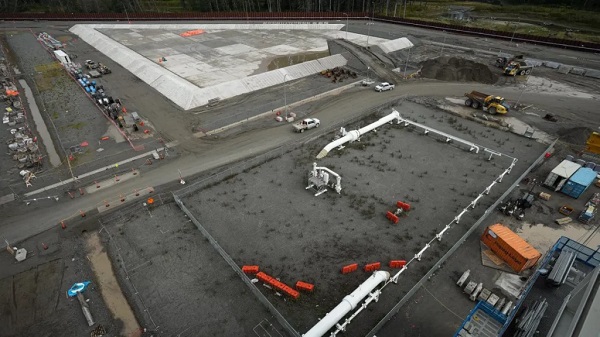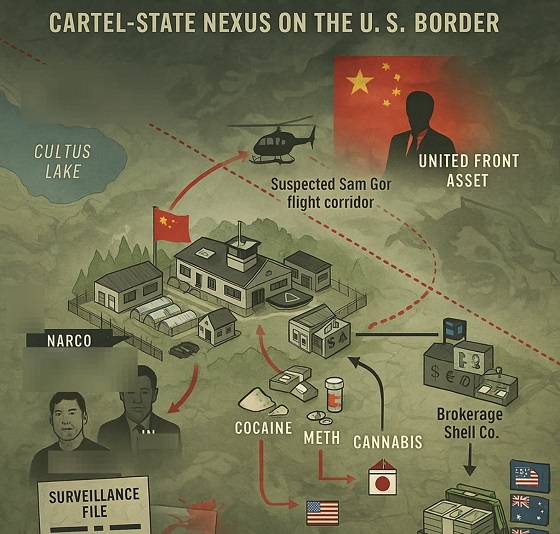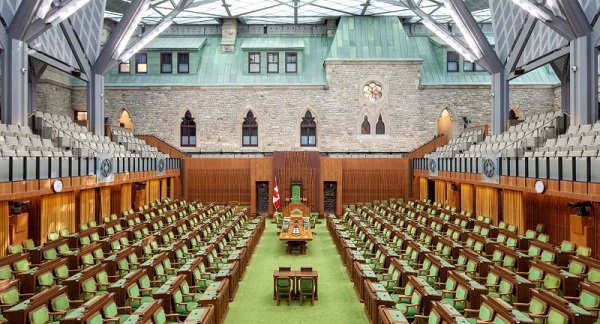Energy
It’s time to get excited about the great Canadian LNG opportunity

 By Stewart Muir
By Stewart Muir
Canada has a rare window to join the big leagues of LNG exporters—Qatar, Australia, and the United States are not waiting around, and neither should we.
I sometimes catch myself staring out over the waters of British Columbia’s coastline — so calm, so vast, so brimming with unspoken opportunity — and I can’t help but wonder how anyone could fail to notice the promise that Liquefied Natural Gas (LNG) represents for our nation’s future. This country sits atop some of the largest gas reserves on Earth, and we have two coasts eager to connect our product to global markets.
I’m a quietly enthusiastic type by nature, and I don’t often indulge in the “I-told-you-so” routine, but whenever I encounter someone who just hasn’t cottoned on to the excitement around LNG, I feel compelled to stage a gentle intervention.
In my day-to-day role as CEO of Resource Works, I work with communities from Fort St. John to Kitimat, and beyond. Let me assure you, if you want to see Canadians at work, proud of their craft, and eyeing a brighter future, you’ll find them along the pipeline routes and port terminals that are part of our budding LNG industry. And they’re just as commonly found in Vancouver, Victoria and the other cities, just harder to spot with no blue coveralls.
I’ve been following the natural gas story in British Columbia for more than a quarter of a century, going back to my days in the media field. As an editor at The Vancouver Sun, I created the paper’s first-ever energy beat after we noticed something big was stirring in the North East gas fields. It turned out to be an industry animated by regulatory innovation, rich geology, ambitious investors, and some of the most capable people you’ll ever meet.
When talk of LNG exports began to stir in 2011, I dove in with both feet. Over the past 15 years, I’ve followed the LNG file across Canada, around the world, and deep into the heart of British Columbia.
Along the way, I’ve met First Nations chiefs who proudly showed me the schools and businesses they built through new partnerships. I’ve also sat down with those who remain skeptical and had honest, sometimes searching conversations. I’ve learned something from all of them. This is an industry that, at its best, brings people together to solve problems, create opportunity, and build a future worth caring about.
Why am I still so enthused after all these years? LNG is not a flash in the pan, for starters. Through cyclical ups and downs—natural phenomena in any commodity game—international forecasts consistently show that LNG demand won’t be evaporating tomorrow or, quite likely, for several tomorrows yet. The International Energy Agency, the Canada Energy Regulator, and even the U.S. Energy Information Administration all point to steady growth in global LNG trade.
On top of that, if you follow the money, you’ll see billions of dollars flowing into new regasification terminals and record orders for LNG carriers. I may be old-fashioned, but I’ve always found that when so many investors plunk down their capital in one place, it’s seldom a fluke. The world has more than 700 LNG ships plying the seas these days, and hundreds more under construction. That’s not a small bit of confidence.
And let’s talk local: from where I sit, Canada’s jobs outlook tied to LNG looks like a real tonic for communities seeking new opportunities. Construction alone can employ entire regions. Then come the careers that last decades—plant operators, engineers, port and shipping managers, the works. It’s the sort of diversified prosperity that a resource economy yearns for.
We’ve even seen First Nations communities take equity stakes in major LNG projects, forging new partnerships that benefit everyone involved. That’s the model of inclusive economic development that Canadians like to talk about. It’s called walking the walk.
Those voices of skepticism — bless their hearts — sometimes say, “But what about price volatility? The commodity cycles? Are we sure this is sustainable?” Truthfully, no commodity is immune to upswings and downswings. But open a newspaper — digitally or in paper form, your choice— and you’ll find that countries all over the world are expanding their LNG-import infrastructure. Many of them, especially in Asia and Europe, see Canada as a steady, well-regulated, and (importantly) speedy supplier.
Yes, “speedy” might be an odd descriptor for us easygoing Canadians, but let’s not overlook that a West Coast port is only about eight or nine sailing days from major Asian markets, versus more than 20 from the U.S. Gulf Coast. You’d think we’d have lines of ships lined up right now, just for that advantage.
There’s another subtlety that some folks overlook. Right now, much of our gas still flows to the United States, often at discounted prices, only to be converted into LNG down there and sold globally at a premium. If that doesn’t make you shake your head in wonder, I’m not sure what will. Canadians have every reason to want to keep some of that up-chain value right here at home, funneling more of that revenue into local jobs and public coffers. That’s exactly the sort of well-to-customer supply chain we’re poised to build.
And if you’re still not impressed, consider the big jolt to GDP whenever a massive energy project crosses the finish line. Look no further than the Trans Mountain pipeline expansion: once it was substantially complete last year, the national GDP got a measurable jolt. It’s extremely rare that a single anything shows up that way. Now, with the first shipment of Canadian LNG preparing to leave Kitimat in the coming weeks, we can expect a repeat performance. It’s the real economic equivalent of an encore, if you will. And who doesn’t love an encore that boosts paycheques and government revenues?
Canadians may be known worldwide for politeness and hockey, but let’s not forget that boldness is also in our national DNA. Building a robust LNG sector that ties Western and Eastern Canada to major global markets is about as bold an economic strategy as we could pursue right now. Some might call it visionary, others might say it’s just common sense in a world that still demands substantial amounts of energy. Either way, Canada has a rare window to join the big leagues of LNG exporters—Qatar, Australia, and the United States are not waiting around, and neither should we.
At the end of the day, seeing Canadians capture more of the value from our natural resources rather than shipping it across the border at a discount is, for me, both pragmatic and patriotic. It’s the kind of deal that makes you wonder why anyone would hesitate. Perhaps that hesitation is just a bump in the road of public discourse—something we can gently, politely, and persistently overcome.
I, for one, am excited for the first shipment of LNG out of Canada’s West Coast, due any week now. A top executive with the project once whispered to me that the maiden cargo would be worth $100 million, but lately I’m hearing a single shipload is now probably worth double that.
So yes, I’m looking forward to the day when it’s not just a handful of tankers leaving our ports, but a regular fleet serving global customers. It will lift up the whole country, just as it has contributed to America’s tearaway economy in recent years and elevated Qatar from desert outpost to World Cup host nation.
Soon, maybe all the doubters will have recognized the obvious — and joined the rest of us on the bandwagon with front-row seats to Canada’s LNG future. Sure, I’m biased, but only because the facts keep reinforcing that this sector is poised to do a world of good for Canadians from coast to coast.
Business
EPA to shut down “Energy Star” program

 MxM News
MxM News
Quick Hit:
The Environmental Protection Agency is planning to shut down its long-standing Energy Star program, which has certified energy-efficient appliances for over three decades. The move is part of a sweeping agency reorganization that also includes eliminating the climate change office and other environmental initiatives not mandated by law.
Key Details:
- EPA officials announced the dismantling of the Energy Star program in a staff meeting on May 6, 2025.
- The agency is eliminating its climate-related divisions, including those overseeing Energy Star and greenhouse gas reporting.
- The move is framed as part of a broader restructuring to prioritize statutory obligations and reduce government overreach.
Diving Deeper:
In a significant shift for federal environmental policy, the Environmental Protection Agency will eliminate the Energy Star program, a popular certification used to identify energy-efficient home appliances like refrigerators, dishwashers, and dryers. Internal documents and a recorded staff meeting reveal that EPA leadership is dismantling entire divisions focused on climate change and voluntary energy initiatives.
Paul Gunning, director of the EPA’s Office of Atmospheric Protection—which is also being cut—told staff the agency would “de-prioritize and eliminate” all climate-related work outside of what’s legally required. The Energy Star program, created in 1992 under President George H.W. Bush, has helped save American households and businesses over $500 billion in energy costs and prevented billions of metric tons of greenhouse gases from entering the atmosphere.
Supporters argue the program has been a bipartisan success story. Nearly 90% of U.S. consumers recognize the Energy Star label, and manufacturers have long relied on it to market efficient products. Even the U.S. Chamber of Commerce and major industries, from lighting to food-equipment makers, have urged the EPA to keep it in place. A joint letter in March from dozens of trade organizations to EPA Administrator Lee Zeldin warned that ending the program would not benefit Americans.
Critics of the move, like Paula R. Glover of the Alliance to Save Energy, say the Energy Star program costs just $32 million annually but delivers $40 billion in utility bill savings. “Eliminating the Energy Star program is counterintuitive to this administration’s pledge to reduce household costs,” she said. Glover added that with electricity demand set to rise 35–50% by 2040, energy-saving measures are more important than ever.
The Biden-era EPA heavily prioritized climate policy and environmental regulation, often blurring the lines between environmental stewardship and bureaucratic overreach. In contrast, the current administration—under 47th President Donald Trump—is refocusing the agency toward its statutory mission, aligning with the broader conservative agenda of streamlining government and cutting redundant or ideologically-driven programs.
While Trump previously attempted to defund Energy Star during his first term, the effort failed amid bipartisan concern that privatization could lead to lowered standards. The current plan appears to accomplish the same goal through internal restructuring, cutting not just Energy Star but programs related to methane emissions reduction, climate science, and policy.
Notably, the agency’s largest union has cried foul over how the reorganization was handled. Marie Owens Powell, its president, accused the agency of “union busting” after being blocked from attending reorganization meetings. Staff have been told they may be reassigned or let go as the EPA scales back to staffing levels not seen since the Reagan administration.
For an agency that has long served as the regulatory spearhead for the left’s climate agenda, this realignment could represent a return to core environmental functions—clean air and water—while removing the taxpayer burden of subsidizing climate-centric programs with questionable returns. The decision also signals a shift away from corporatist alliances that prop up select industries under the guise of energy policy.
Business
Innovative Solutions Like This Plan To Provide Power For Data Centres Will Drive Natural Gas Demand For Decades


From the Daily Caller News Foundation
By David Blackmon
The dramatic expansion of the number and scale of planned datacenter projects across the United States has generated a great deal of news over the last year. The central question in many of those stories centers around the power needs of these projects, and how the power will be generated.
Early developers hyped their preference to use electricity generated by wind and/or solar to power their projects but found the 99.999% datacenter uptime requirements can’t be met by these intermittent power sources, even when backed up by stationary batteries.
With new nuclear projects facing permitting times of 10-15 years and coal being crowded out by emissions regulations, more recent speculation has centered heavily on natural gas as being the fuel of choice for developers whose projects won’t be interconnected into a regional power grid. Natural gas generation is cheaper and faster to build than nuclear, and, while anti-fossil fuel activists complain that gas still comes with emissions, it presents a far cleaner alternative to coal.
In Wyoming, a group of three companies said this week they’ve agreed to a joint project that also satisfies the emissions critics. In a release dated May 6, data center developer Prometheus Hyperscale, Wyoming’s largest gas producer PureWest Energy, and carbon capture and storage (CCS) developer Frontier Carbon Solutions, LLC, rolled out what they call “a first-of-its-kind partnership focused on driving innovation and sustainability while contributing to Wyoming’s long-term economic growth.”
In simple terms, the plan goes like this:
- Prometheus will permit and build the datacenter;
- PureWest will produce and supply the natural gas to a nearby power plant operated by an independent power provider from its Wyoming production portfolio, which it boasts maintains “industry leading emissions performance with a rigorous Measurement, Monitoring, Reporting and Verification (MMRV) program and ISO 14067 verification;”
- Frontier will capture biogenic carbon dioxide from across the Mountain West and sequester it in underground formations in Southwestern Wyoming; and
- Frontier will sell traceable carbon removal credits to Prometheus.
Through entering into these various agreements, a datacenter sporting a net-zero emissions profile is created. This not only embellishes the clean energy scorecards for the three companies involved in the partnership, but also for customers who purchase the computing power from the datacenter, as well as the operators of processing plants and transportation systems which move both the natural gas and the carbon dioxide.
“PureWest’s goal to be the region’s energy supplier of choice is rooted in innovation and cutting-edge technology, and today’s exciting announcement reflects our ongoing mission and progress,” said Ty Harrison, President and CFO of PureWest said in a release. “We’re proud to partner with Prometheus and Frontier because this project affirms the critical role that verified low-carbon natural gas will play in sustainably meeting the growing energy needs of AI and its related infrastructure. PureWest is committed to ensuring Wyoming continues to be a leader in delivering scalable energy and decarbonization solutions for the data-driven future of the United States.”
While the joint venture is fairly complex with a number of moving parts, it actually represents a pretty ingenious solution. Once up and running, the partners end up creating a major datacenter with the same carbon footprint as one powered by wind or solar would have, but which will enjoy the added benefit of being able to meet its 99.999% uptime requirements.
But it’s more than that. As the Trump administration’s energy and climate regulatory agenda moves ahead to consolidation, these companies will also avoid running into the reality of so many U.S. wind and solar projects becoming financially unsustainable when the endless stream of rising subsidies their business models require are inevitably reduced or cut off entirely.
As the religious global fervor driven by climate alarmism continues its inevitable fade, producers of American natural gas like PureWest will find themselves presented with a wide array of innovative opportunities like this one. Those opportunities will be driven by customers and potential partners who need the combination of abundance, affordability, reliability, speed of development and low emissions profile that only natural gas is capable of providing.
Anyone who still believes that oil and gas is a dying industry is in for a very rude awakening.
David Blackmon is an energy writer and consultant based in Texas. He spent 40 years in the oil and gas business, where he specialized in public policy and communications.
-

 Crime2 days ago
Crime2 days agoInside B.C.’s Cultus Lake Narco Corridor — How Chinese State-Linked Syndicates are Building a Narco Empire in Canada
-

 Business2 days ago
Business2 days agoTrump praises Carney at White House, says ‘never say never’ about 51st state
-

 Business2 days ago
Business2 days agoCanada’s Election Is Over And Now The Real Work Begins
-

 Business1 day ago
Business1 day agoCarney pivots from anti American campaign, embracing US and hailing Trump as “transformational president”
-

 Daily Caller23 hours ago
Daily Caller23 hours agoMisguided Climate Policies Create ‘Real Energy Emergency’ And Permit China To Dominate US
-

 Business1 day ago
Business1 day agoTop business group warns Carney’s ‘net zero’ push spells disaster for Canada’s economy
-

 Also Interesting2 days ago
Also Interesting2 days agoData Loss Prevention Strategies to Improve Google Drive Security
-

 Health1 day ago
Health1 day agoTrump signs order to stop funding for gain-of-function research believed to have caused COVID





